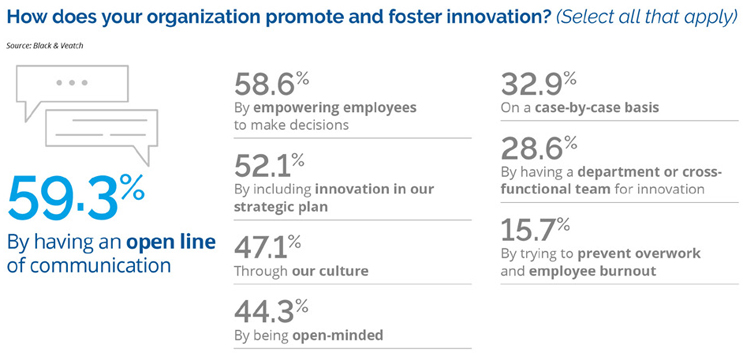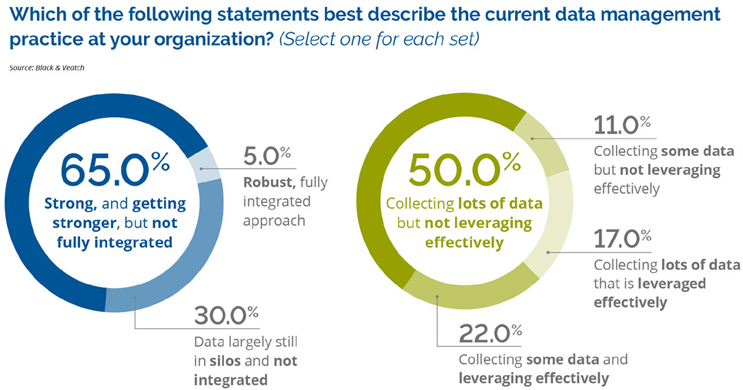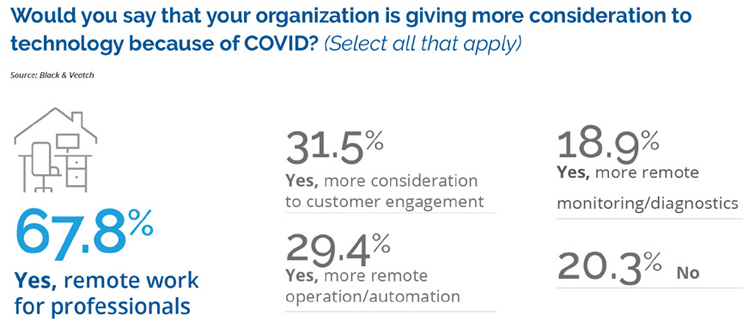Finding New Ways Through
By Cindy Wallis-Lage

The president of Black & Veatch's water business reveals the findings of the company’s annual water survey and report, offering a snapshot of where we stand and insight on what is needed.
When the flow of water is restricted, it eventually finds new pathways. The same can be said of the water industry over the course of the past year. Our 2021 Strategic Directions: Water Report, released in August, examines the issues and trends affecting the water sector. A top takeaway in this year’s report — based on a survey of more than 200 stakeholders in water, wastewater, and stormwater combined with expert analysis — is that mounting challenges also provided opportunities for improvement. As an industry, we found new ways to keep water clean and flowing productively.
Adaptation And Resilience
Survey respondents confirmed that aging infrastructure is still the most challenging issue, but justifying capital improvements and rate requirements, achieving or maintaining resilient systems, and managing capital costs are also key issues. The COVID-19 pandemic exacerbated concerns about aging assets and funding, cutting into revenues and cash flows. Two-thirds of survey respondents reported that the outbreak had at least a moderate impact on day-to-day operations, with smaller systems feeling a bigger impact.
Concerns about disasters related to climate change are driving decisions about how to make assets resilient against droughts, floods, wildfires, and system shocks such as February’s deep freeze in Texas that disrupted water services to millions. But by and large, survey respondents’ focus remains on meeting required standards and keeping systems running. Larger water utilities listed resiliency as their third-highest priority, behind water quality and matters that involve asset management or replacement.
Sustainability can help drive resilience. Renewable energy (49 percent) and water-loss mitigation (nearly 44 percent) top the list of sustainability strategies among respondents asked to select all applicable options, followed by new/alternative water supplies (32 percent).
Wastewater utilities historically have been stewards for the environment, and environmental protection continues to be a guiding principle, even as new ways of doing so emerge. The water industry is heading in the right direction with a multifaceted approach to reduce the number, environmental footprint, and cost of inputs, with triple-bottom-line benefits for communities as a reward.
Despite the additional burden on an already underfunded industry, water utilities adapted remarkably well. Rising interest in analytics and other technologies that facilitate decisions and remote operation are helping communities change the way they work, optimize assets, and prioritize system investments.
Reinvention And Innovation
The water industry hasn’t always been nimble or quick to adopt new technologies. Escalating challenges and the rapid reinvention necessitated by COVID-19 have accelerated the need for innovation. Report authors concur that the industry is on the right path, with some industry stakeholders farther down the path than others.
The survey shows that water industry leaders strive to spark innovation through multiple means. More than half of respondents’ organizations promote innovation through open lines of internal communication, empowering employees to make decisions, and folding innovation into their strategic plans (Figure 1). Innovation is also encouraged in other ways.

Figure 1
Bold new strategies. The report holds up the Hampton Roads Sanitation District’s Sustainable Water Initiative for Tomorrow (SWIFT) program as an example of thinking big and looking ahead. The program, which seeks to eventually inject 120 MGD of treated wastewater into a shrinking aquifer to replenish it and lessen what’s released into rivers, shows that bold ideas can indeed take root in a sector traditionally slow to change.
Another example of innovative thinking showcased in the report is a sediment-diversion project. By letting sediment-rich water pass through a levee, the project will rebuild wetlands eroded by hurricanes and rising sea levels. This and other nature-based solutions help mitigate environmental issues associated with development and other human activity.
The Pure Water San Diego program, which will provide more than 40 percent of San Diego’s water supply locally by the end of 2035 and reduce ocean discharges, additionally exemplifies how communities are charting new, more sustainable courses.
When planning tomorrow’s infrastructure, strategic focus on opportunities to integrate water and other resources into a broader circular economy merits consideration. For example, co-locating a water resource recovery facility next to a manufacturing facility that needs cooling water can be mutually beneficial. Taking the concept a step further, co-locating a facility next to a factory that produces packing chips could yield renewable natural gas as an output from the treatment facility and an input for industrial production.
Working smarter. Leveraging digital technology offers the opportunity to harness data precisely, leading to enhanced capabilities in tracking consumption, optimizing performance, driving efficiencies and customer engagement, and prioritizing investments.
As the survey shows, water, wastewater, and stormwater utilities appear to be increasing their engagement with digital and electronic management approaches. Utilities found that their data management was perhaps not as robust as they thought during the operational challenges posed by COVID-19, inspiring them to improve their use of information. They are becoming more comfortable using data from online sensors, with nearly nine out of 10 respondents somewhat or very confident in the accuracy of their sensor-derived data. Meanwhile, 65 percent categorized their overall data management practices as strong and getting stronger but not fully integrated. In a separate question, half the respondents reported they are collecting lots of data but aren’t capitalizing fully on their power. (Figure 2). Comfort with digital technology is increasing, but siloed data still preclude a clear picture of asset health and investment in many cases.
The merit of remote water-utility work during the pandemic was a revelation for many, and remote work necessitated greater use of technology. More than two-thirds of respondents (68 percent) cited the pandemic for stimulating their use of technology for remote work by professionals. In addition, roughly three in 10 linked the outbreak to more consideration of technology for better customer engagement and/or more remote operation and automation (Figure 3).

Figure 2
In February, a reminder that increased use of remote-access technology carries risks as well as rewards surfaced in Florida. ABC News reported, citing a memo by federal investigators, that an older version of Windows and a vulnerable network allowed a hacker to access a Florida water treatment plant’s computer system. Authorities said the hacker used a remote-access program shared by workers at a plant in Oldsmar to try to taint the city’s water supply with a caustic chemical. Fortunately, a plant manager noticed and thwarted the tampering intent before any major damage could occur. Evaluating cybersecurity is even more important with increased remote operations and management of water systems, which can be easy prey for hackers because the computer infrastructure of local governments tends to be underfunded and IT departments are already stretched thin.
Infrastretching. Utilities are managing to stretch their funding by investing in existing assets. “Process intensification” can maximize the performance of existing process facilities, which helps utilities improve efficiency, avoid costly new construction, and lower their carbon footprints. As one example, advances in biofilm technology have facilitated intensification of biological processes.
Continued Transformation And Collaboration
Another key message in the report is that there’s more to do, and it’s time to do it. Report authors recommend:
- Investing in systems.
- Leveraging new and anticipated sources of funding.
- Planning in an integrated, holistic manner with a “One Water” mindset.
- Working with community leaders to prioritize water as a way to revitalize and equitably build sustainable communities of the future.
- Collaborating with partners both within and outside the water industry

Figure 3
Utilities have several options for funding capital projects. Various programs and partnership opportunities provide communities with flexible, low-cost financing to address their highest-priority water quality infrastructure projects. Approximately one in four respondents said their organizations have investigated public-private partnerships for capital project funding. Less than 10 percent have explored community-based partnerships, although interest in such partnerships appears to be rising.
Food production offers another chance to be collaborative. The survey revealed that many utilities have an eye on agricultural reuse, second only to industrial reuse. Water and agriculture interests overlap, suggesting an opportunity for collaborative pursuit of mutually beneficial strategies and solutions. Commonalities include hydroponics as well as effective management and recovery of water and nutrient resources. Some utilities are already working with growers to recover and treat water for agricultural use. Everyone can benefit if utilities examine agricultural needs and seek new ways to capitalize on shifting priorities, new concepts, and hightech capital infusion. The water sector has a crucial role in feeding the world, too.
About The Author
 Cindy Wallis-Lage is president of Black & Veatch’s water business, leading the company’s efforts to address water infrastructure needs around the world. A longtime global champion for water resources, she promotes the value of water and the importance of resilience to help communities achieve social, economic, and environmental sustainability goals. A member of the Black & Veatch Board of Directors since 2012, she also serves on the Board of Directors for the U.S. Water Alliance and on the Leadership Council for Water For People.
Cindy Wallis-Lage is president of Black & Veatch’s water business, leading the company’s efforts to address water infrastructure needs around the world. A longtime global champion for water resources, she promotes the value of water and the importance of resilience to help communities achieve social, economic, and environmental sustainability goals. A member of the Black & Veatch Board of Directors since 2012, she also serves on the Board of Directors for the U.S. Water Alliance and on the Leadership Council for Water For People.
